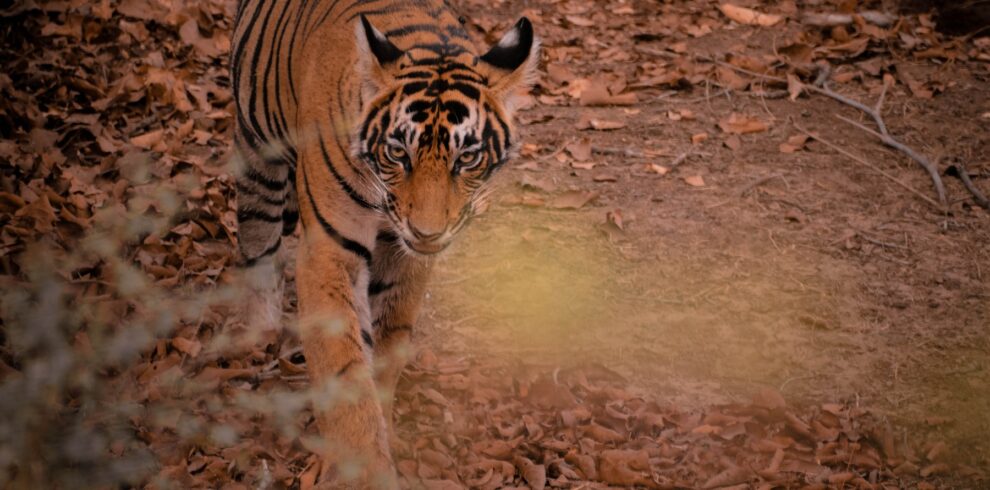Ranthambore
Ranthambore National Park, situated in the Sawai Madhopur district of the Indian state of Rajasthan, is one of the most renowned tiger reserves in India. Spread over an area of approximately 392 square kilometers, Ranthambore is a haven for wildlife enthusiasts and nature lovers, famous for its population of royal Bengal tigers.
Originally established as the Sawai Madhopur Game Sanctuary in 1955, Ranthambore was declared a national park in 1980 and later became a part of the larger Project Tiger conservation program. The park is characterized by its diverse landscapes, which include dry deciduous forests, grasslands, lakes, and rocky outcrops, providing a varied habitat for a wide range of wildlife species.
The star attraction of Ranthambore National Park is undoubtedly its population of Bengal tigers. Ranthambore is known for offering one of the best opportunities to spot these majestic big cats in their natural habitat. Visitors can embark on thrilling safari excursions through the park in open 4×4 vehicles or canters, accompanied by experienced guides and naturalists, in search of tiger sightings.
In addition to tigers, Ranthambore is home to a rich and diverse array of wildlife, including leopards, sloth bears, jungle cats, sambar deer, spotted deer, nilgai, wild boar, and a variety of bird species. The park is a paradise for birdwatchers, with over 300 species of birds recorded within its boundaries, including migratory birds that visit during the winter months.
Apart from its wildlife, Ranthambore is also known for its historic landmarks, including the majestic Ranthambore Fort. Perched atop a rocky hill within the park, the fort offers panoramic views of the surrounding landscape and provides insights into the region’s rich history and cultural heritage.
Overall, Ranthambore National Park offers a unique and unforgettable wilderness experience, combining the thrill of tiger sightings with the beauty of its natural landscapes and the richness of its cultural heritage. Whether you’re a wildlife enthusiast, nature lover, or history buff, Ranthambore has something to offer for everyone.
City Tour

- Jan
- Feb
- Mar
- Apr
- May
- Jun
- Jul
- Aug
- Sep
- Oct
- Nov
- Dec

- Jan
- Feb
- Mar
- Apr
- May
- Jun
- Jul
- Aug
- Sep
- Oct
- Nov
- Dec
Cultural Tours
Tourism is travel for pleasure or business; also the theory and practice of touring, the business of attracting, accommodating, and entertaining tourists, and the business of operating tours. Tourism may be international, or within the traveller’s country. The World Tourism Organization defines tourism more generally, in terms which go “beyond the common perception of tourism as being limited to holiday activity only”, as people “traveling to and staying in places outside their usual environment for not more than one consecutive year for leisure, business and other purposes”.
Tourism can be domestic or international, and international tourism has both incoming and outgoing implications on a country’s balance of payments. Today, tourism is a major source of income for many countries, and affects the economy of both the source and host countries, in some cases being of vital importance.

- Jan
- Feb
- Mar
- Apr
- May
- Jun
- Jul
- Aug
- Sep
- Oct
- Nov
- Dec

- Jan
- Feb
- Mar
- Apr
- May
- Jun
- Jul
- Aug
- Sep
- Oct
- Nov
- Dec
Jungle Safari
A is an overland journey, usually a trip by tourists to Africa. In the past, the trip was often a big-game hunt, but today, safari often refers to trips to observe and photograph wildlife—or hiking and sightseeing, as well.
The Swahili word safari means journey, originally from the Arabic meaning a journey; the verb for “to travel” in Swahili is kusafiri. These words are used for any type of journey, e.g. by bus from Nairobi to Mombasa or by ferry from Dar es Salaam to Unguja. Safari entered the English language at the end of the 1850s thanks to Richard Francis Burton, the famous explorer.
The Regimental March of the King’s African Rifles was ‘Funga Safari’, literally ‘tie up the March’, or, in other words, pack up equipment ready to march.
In 1836 William Cornwallis Harris led an expedition purely to observe and record wildlife and landscapes by the expedition’s members. Harris established the safari style of journey, starting with a not too strenuous rising at first light, an energetic day walking, an afternoon rest then concluding with a formal dinner and telling stories in the evening over drinks and tobacco.

- Jan
- Feb
- Mar
- Apr
- May
- Jun
- Jul
- Aug
- Sep
- Oct
- Nov
- Dec

- Jan
- Feb
- Mar
- Apr
- May
- Jun
- Jul
- Aug
- Sep
- Oct
- Nov
- Dec
Multi Day Tour

- Jan
- Feb
- Mar
- Apr
- May
- Jun
- Jul
- Aug
- Sep
- Oct
- Nov
- Dec

- Jan
- Feb
- Mar
- Apr
- May
- Jun
- Jul
- Aug
- Sep
- Oct
- Nov
- Dec